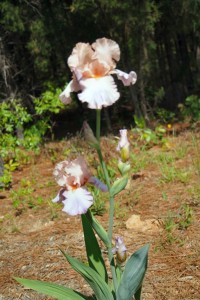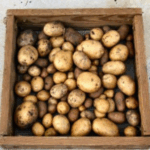
Or: The Importance of Keeping a Gardening Journal
I love mystery and detective stories. And while I aspire to be Jane Marple or Hercule Poirot, I’m a bit more like Nancy Drew (on a good day) or Shaggy and Scooby-Do (when Shadow is with me).
Take the mysterious plants in my garden.
I have this gorgeous iris in the back of the flower garden. I planted three groups of iris last year in that spot, and two emerged, victorious. I know that the two are the same variety, for I bought two of the same and one different – and arranged them in the garden as A, B and A.
But for the life of me, I couldn’t remember what “A” was called. And my little plant marker made from a recycled cake frosting can was wiped clean by the winter snows. So much for permanent markers. I think they only remain permanent when I accidentally draw on my white shirts with them.
Then I remembered. My gardening journal!
What a fancy name for a three ring binder stuffed with loose leaf and with seed packets and plant labels Scotch-taped onto the pages.
But there it was: Iris, Cherub’s Smile!
Hooray!
And another clump of mystery plants identified: old fashioned Sweet William. I’ve never grown them before, completely forgotten I’d planted them, and the plant labels are again missing in action thanks to Shadow chasing her tennis ball and plowing right into the flower bed.
A garden journal doesn’t have to be fancy or pretty. Mine sure isn’t. But it sure is helpful.
You can:
- Tape the seed packets to a piece of paper and note the day planted, day harvested, or day bloomed. This can help your planning for next year.
- Keep track of wildlife sitings.
- Note unusual weather, such as early frosts or droughts
- Track fertilizing dates and types so you can see what works
- Note any pests you’ve encountered – and what you did to rid yourself of them
- and whatever else you fancy
So if you’re not keeping a gardening journal, grab some paper, an old notebook, or whatever pleases you, and start one today. They really help.
I’m living proof!





I am getting better at writing down the names of my plants. this year I have made labels for my plants with a label maker, so I will see how long the writing lasts.
Hi Jeanne! Very nice post and good tips!